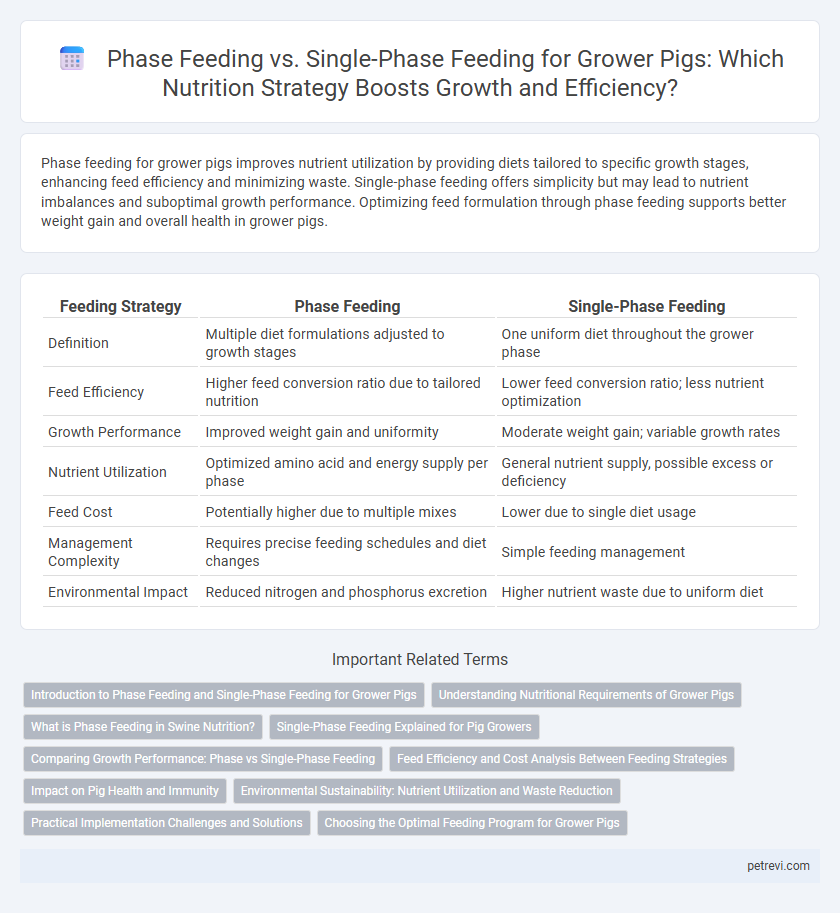Phase feeding for grower pigs improves nutrient utilization by providing diets tailored to specific growth stages, enhancing feed efficiency and minimizing waste. Single-phase feeding offers simplicity but may lead to nutrient imbalances and suboptimal growth performance. Optimizing feed formulation through phase feeding supports better weight gain and overall health in grower pigs.
Table of Comparison
| Feeding Strategy | Phase Feeding | Single-Phase Feeding |
|---|---|---|
| Definition | Multiple diet formulations adjusted to growth stages | One uniform diet throughout the grower phase |
| Feed Efficiency | Higher feed conversion ratio due to tailored nutrition | Lower feed conversion ratio; less nutrient optimization |
| Growth Performance | Improved weight gain and uniformity | Moderate weight gain; variable growth rates |
| Nutrient Utilization | Optimized amino acid and energy supply per phase | General nutrient supply, possible excess or deficiency |
| Feed Cost | Potentially higher due to multiple mixes | Lower due to single diet usage |
| Management Complexity | Requires precise feeding schedules and diet changes | Simple feeding management |
| Environmental Impact | Reduced nitrogen and phosphorus excretion | Higher nutrient waste due to uniform diet |
Introduction to Phase Feeding and Single-Phase Feeding for Grower Pigs
Phase feeding for grower pigs involves adjusting the diet composition in multiple stages to meet the changing nutritional requirements as pigs develop, improving feed efficiency and growth performance. Single-phase feeding provides a uniform diet throughout the grower phase, simplifying management but potentially leading to nutrient imbalances and suboptimal growth. Research shows that phase feeding optimizes nutrient utilization and reduces feed costs by targeting specific amino acids, energy, and mineral needs during each growth stage.
Understanding Nutritional Requirements of Grower Pigs
Phase feeding for grower pigs aligns nutrient supply closely with their changing nutritional requirements, enhancing feed efficiency and growth performance. Single-phase feeding provides a uniform diet throughout the growth period, which can lead to nutrient under- or oversupply, impacting both health and growth rates. Tailoring protein, energy, vitamins, and minerals in phase feeding supports optimal lean tissue deposition and reduces feed costs compared to a single-phase feeding strategy.
What is Phase Feeding in Swine Nutrition?
Phase feeding in swine nutrition involves adjusting the diet of grower pigs according to their specific growth stages and nutritional requirements. Unlike single-phase feeding, which provides a uniform diet throughout the growth period, phase feeding tailors protein, energy, and mineral levels to optimize feed efficiency, promote better growth rates, and reduce nutrient waste. This targeted approach enhances overall pig health and supports sustainable swine production practices.
Single-Phase Feeding Explained for Pig Growers
Single-phase feeding for grower pigs involves providing a consistent diet throughout the entire growth period, simplifying feed management and reducing labor costs. This method contrasts with phase feeding, which adjusts nutrient levels at different growth stages to optimize performance and minimize waste. Single-phase feeding can be effective for pig growers seeking operational efficiency, especially in systems where precise nutrient tailoring is less critical.
Comparing Growth Performance: Phase vs Single-Phase Feeding
Phase feeding for grower pigs optimizes nutrient delivery by adjusting diet composition to the pigs' developmental stages, resulting in improved average daily gain (ADG) and feed conversion ratio (FCR) compared to single-phase feeding. Research indicates that phase feeding reduces nutrient wastage and enhances the efficiency of nutrient utilization, supporting more consistent growth performance. Single-phase feeding often leads to imbalanced nutrient supply, which can limit growth potential and increase feed costs due to over- or under-feeding specific nutrients.
Feed Efficiency and Cost Analysis Between Feeding Strategies
Phase feeding for grower pigs enhances feed efficiency by precisely matching nutrient supply with the pigs' developmental stages, reducing nutrient wastage and improving growth rates compared to single-phase feeding. Cost analysis demonstrates that phase feeding lowers overall feed expenses by minimizing overfeeding and optimizing ingredient utilization, despite potentially higher management complexity. In contrast, single-phase feeding simplifies feeding procedures but often results in suboptimal nutrient provision, leading to increased feed costs and reduced feed efficiency.
Impact on Pig Health and Immunity
Phase feeding in grower pigs enhances nutrient utilization by adjusting diets to specific growth stages, which supports optimal immune function and reduces disease susceptibility. In contrast, single-phase feeding may lead to nutrient imbalances that compromise gut health and weaken immune responses. Improved health outcomes from phase feeding result in better growth performance and lower mortality rates in pig populations.
Environmental Sustainability: Nutrient Utilization and Waste Reduction
Phase feeding for grower pigs enhances environmental sustainability by optimizing nutrient utilization through tailored diets that match the pigs' growth stages, reducing nutrient excretion and minimizing waste. Single-phase feeding often results in nutrient imbalances and higher nitrogen and phosphorus losses, contributing to environmental pollution. Implementing phase feeding strategies significantly lowers the environmental footprint by improving feed efficiency and decreasing the accumulation of manure nutrients that can contaminate soil and water resources.
Practical Implementation Challenges and Solutions
Phase feeding for grower pigs involves adjusting nutrient levels according to growth stages, optimizing feed efficiency and reducing waste, but it requires precise formulation and careful monitoring of weight gain to avoid nutrient imbalances. Single-phase feeding simplifies management by using a uniform diet throughout the grower period, yet it may lead to over- or under-supply of key nutrients, potentially impacting growth performance and feed cost efficiency. Practical solutions for phase feeding challenges include employing automated feeding systems, regular body weight assessments, and flexible feed formulation software to ensure accurate nutrient provision aligned with growth dynamics.
Choosing the Optimal Feeding Program for Grower Pigs
Phase feeding for grower pigs improves nutrient utilization by matching dietary formulations to specific growth stages, enhancing feed efficiency and reducing waste. Single-phase feeding simplifies management but may lead to nutrient imbalances and suboptimal growth rates. Selecting the optimal feeding program depends on balancing cost, labor, and the production goals for maximizing weight gain and feed conversion efficiency.
Phase feeding vs Single-phase feeding for Grower pigs Infographic

 petrevi.com
petrevi.com